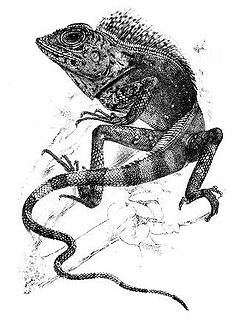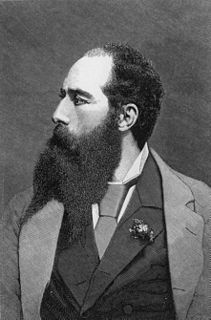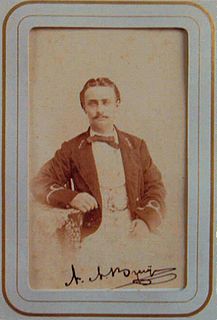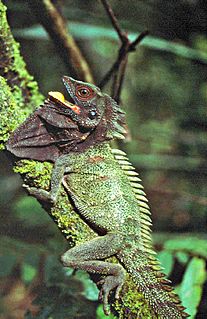
Gonocephalus is a genus of agamid lizards endemic to southeast Asia.
Hypsilurus is a genus of arboreal lizards in the family Agamidae. The genus is endemic to Melanesia.

Luigi Maria D'Albertis was an Italian naturalist and explorer who, in 1875, became the first Italian to chart the Fly River in what is now called Papua New Guinea. He undertook three voyages up this river from 1875 to 1877. The first was conducted in the steamer SS Ellengowan and the other two in a smaller ship named the "Neva" which was chartered from the Government of New South Wales. Throughout the three voyages, D'Albertis was consistently involved in skirmishes with the various indigenous people living along the river, using rifle-fire, rockets and dynamite to intimidate and, on occasions, kill these local people. He also frequently employed destructive dynamite fishing as a technique of obtaining aquatic specimens for his collection. His expedition stole many ancestral remains, tools and weapons from the houses of the locals. He also collected specimens of birds, plants, insects and the heads of recently killed native people. Contemporary explorers and colonial administrators of d'Albertis were almost universally critical of the methods employed by D'Albertis in his expeditions up the Fly and more modern accounts, such as Goode's "Rape of the Fly" are equally condemnatory.

Aglossa caprealis, the stored grain moth, is a moth species of the family Pyralidae. It is found globally, though its native range is presumably western Eurasia or nearby regions, as in other Aglossa species.

The Amphibolurinae are a subfamily of reptiles in the family Agamidae. Members of this subfamily are found in Australia and New Guinea, although one species, the Chinese water dragon, is found in Southeast Asia.

Johann Cesar VI. Godeffroy was a German trader, blackbirder and Hanseat.

Antonie Augustus Bruijn was a Dutch navy officer, naturalist and trader in naturalia from the Dutch East Indies. He was the son-in-law of Maarten Dirk van Renesse van Duivenbode who from 1858 to 1861 provided lodging and assistance to Alfred Russel Wallace when he traveled through the Mollucan islands.
Kalam is a Kalam language of Papua New Guinea. It is closely related to Kobon, and shares many of the features of that language. Kalam is spoken in Middle Ramu District of Madang Province and in Mount Hagen District of Western Highlands Province.

Lophosaurus dilophus, the crowned forest dragon or Indonesian forest dragon, is a large arboreal agamid lizard found in New Guinea and the Moluccan islands, Indonesia.

Lophosaurus is a genus of arboreal agamid lizards from Australia and Melanesia.
Hypsilurus nigrigularis is a species of agamid lizard. It is found in New Guinea.

Hypsilurus auritus is a species of agama found in Indonesia and Papua New Guinea.

Hypsilurus binotatus, the two-marked forest dragon, is a species of agama found in Indonesia and Papua New Guinea.

Hypsilurus bruijnii, the Bruijni forest dragon, is a species of agama found in Indonesia and Papua New Guinea.
Hypsilurus longi is a species of agama found in Papua New Guinea.
Hypsilurus macrolepis, the Solomons tree dragon, is a species of agama found in the Solomon Islands.
Hypsilurus magnus is a species of agama found in Indonesia and Papua New Guinea.
Hypsilurus modestus, the modest forest dragon, is a species of agama found in Indonesia and Papua New Guinea.










